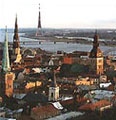Latvia is looking at the year 2001 as a culmination of many things, largely owing to several special anniversaries that will take place that year. The most obvious is that of the restoration of the country's formal independence from Moscow in 1991, which will be highly symbolic throughout the country. However, the country's capital, Riga, also has a very special anniversary coming up: its 800th anniversary. Not many grand cities in the northern half of Europe can boast such a long legacy and live to tell about it.
Renovation and reconstruction have proceeded rapidly over the past few years in Riga, as it also hopes for a dramatic increase in tourism when it becomes the European Cultural Capital in 2001. Riga has the advantage of being the central point among the Baltic states, nearly equidistant from both Tallinn and Vilnius. Many businesses, embassies and organisations established their Baltic regional base in Riga due to this geographic advantage, which, in turn, helped to develop a solid foundation for its tourism industry. Since foreign diplomats and businessmen demand the very best in accommodation, restaurants, bars and entertainment, Riga soon developed a strong and solid base to cater to each of these needs - albeit at a slightly higher price than in Tallinn and significantly higher than in Vilnius.
However, even with the amount of upper-class clientele, the large number of ex-pats in Riga also inspired several "casual" eating and drinking establishments, to which tourists have also flocked. Many give Riga the highest marks for its restaurants and bars among the three Baltic countries, with a good balance of choice and comfort. A good comparison could be made among the Irish pubs in the three capitals. The two best-known Irish pubs in Riga, Tim McShane's and Paddy Whelan's, are more authentic and relaxing. Tallinn's new popular Irish pub, Molly Malone's, is more in line with the Irish pub style found often in America: spiffy, shiny, and trendy - stuffy, in other words. Vilnius's entry, The Twins O'Brien, doesn't even have much of an Irish feel to it.
Tourists enjoy the atmosphere created by the Riga's ex-pat and nouveaux riche communities, taking in the fine seafood at five-star restaurants or sampling cocktails made with Latvia's national drink - the bitter Latvijas Melnais Balzams (Latvian Black Balsam). With the world-famous Latvian National Opera and several dozen good bars, cafes and clubs all within the confines of a small downtown area, Riga has arguably the best nightlife of the three capitals.
Judged purely on tourism, Riga is an absolute gem. Beautiful churches and Jugendstil architecture strewn throughout the old town, along with a lovely park divided by road and stream alike. Large squares bustle with activity, while just steps away lie quiet alleys with impressive buildings to enjoy. Of
 |
| Dome Square in Riga |
However, as attractive a tourist spot as it is, Riga has not yet been given the "crash course" Finnish travellers afforded Tallinn. Surprising lapses occur in otherwise excellent service. For example, in a prominent downtown hotel, "floor ladies" still monitor guests' every move in the old Intourist style. Finding an honest taxi driver in Riga is about as easy as in Prague. The water is not for consumption, and red lights are violated, often to the detriment of even street-wise local pedestrians. The ministerial meeting of the European Bank for Reconstruction and Development (EBRD) in Riga, scheduled for May 2000, will be a good test to see how ready the city is for its anticipated 2001 tourism boom.
With attention fully on Riga in anticipation of the 2001 events, the lag in tourism development for the rest of Latvia becomes more visible. Though Jurmala remains a popular coastal summer resort, even the number of Russian tourists has fallen. Ventspils is a dynamic town boosted by the transit sector, but does not have much of a tourism pull for non-biznesmen types. Some of the nicest sites in Latvia remain hidden: the old Livonian Order stronghold of Cēsis, the spectacular castle ruins (and hydroelectric dams) along the Daugava River, the fascinating Sigulda and its surrounding valley region (and bobsled track!), and the beautiful coastline on Cape Kolga. Many fear that tourists coming to see Riga for its anniversary celebrations during its term as European Cultural Capital will not stray beyond the quick trip to Jurmala or Salaspils, which would be a great shame.
 |
| Ruins of Koknese castle |
Nevertheless, exposure for Riga during its big year could bring a major boost to Latvian tourism as a whole. Quite often, tourists do not venture out of major cities until their subsequent trips to the country. Thus, if Riga succeeds in becoming the big tourist magnet it is poised to be, the regions and their hidden treasures could soon follow. Moreover, not many would like to see thousands of tourists kicking around at the ruins of Koknese castle, lest they realise the dreams of old Soviet planners to send it to the bottom of the Daugava.
 |
| The spire of St Pete's |
Mel Huang, 6 April 2000
Photos courtesy of: the Latvian Tourism Development Agency and Koknese Secondary School.
Latvia Links:
- The Latvia section from In Your Pocket
- Latvian Tourism Development Agency
- Homepage for Riga's 800th Anniversary Celebrations
Baltic Profiles:
Moving on:



